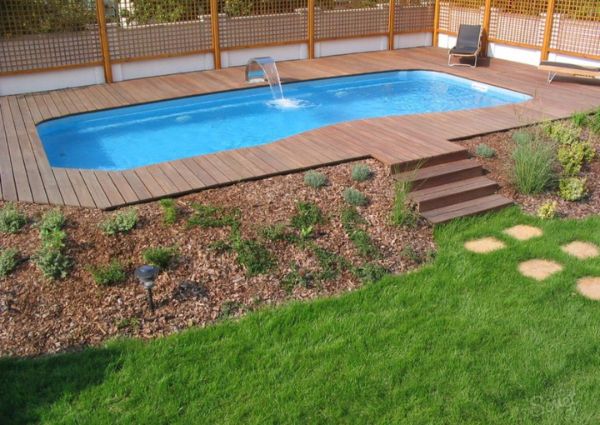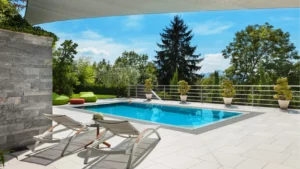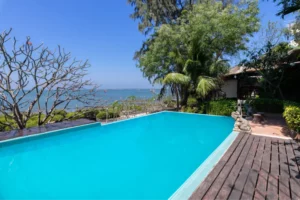If you’re thinking about adding a pool to your backyard oasis, there’s no denying that it’s a big decision. Not only is it a significant investment, but it can also drastically transform the look and feel of your outdoor space. But what to consider when building a pool?
It’s essential to consider several key factors before taking the plunge and diving headfirst into building a pool. From the size and shape of the pool to the type of materials used and the surrounding landscaping, there are many considerations to keep in mind. Let’s dive in.
10 Things You Need to Know
Let’s explore 10 most critical factors you should consider when building a pool to ensure that you end up with a beautiful, functional, and enjoyable addition to your home:
Set a budget
First, you have to budget for your dream pool and plan the expenses in advance to make the right choices. A pool can be a wonderful way to relax, but if you close your eyes and can only see the costs in your head, it may not be the right move for you right now. Discuss the costs and benefits of adding a pool to your property with a financial advisor.
Size, shape, and depth
The type of pool you choose will be determined by a number of factors, including the size and layout of your backyard, the number of people who will use it, and how and how often you intend to use it. If you plan on doing laps, you’ll need a longer and deeper pool. The size of the pool you need will also help you determine the best location for your pool and whether you want to keep lawns and gardens around the area or create a patio lifestyle with the pool as the focal point.

Choose the type of pool you want
In-ground pools are classified into three types: vinyl-lined, fiberglass, and concrete. Before deciding to build a pool, carefully weigh the benefits and drawbacks of each option. A qualified pool builder can guide you through the options and assist you in making the best decision for your backyard.
Pool sanitation system
After you’ve determined the shape, size, and depth of your pool, you’ll need to decide whether you want a chlorine, saltwater, or mineral system. Pools have traditionally used a chlorine-based system because it is both cost-effective and simple. However, it necessitates the regular addition of chlorine and other chemicals into the pool, which may irritate skin and eyes, as well as frequent monitoring of chemical levels.
In recent years, the Mineral system has grown in popularity. It’s a healthier option with soothing water quality and simple maintenance.
The amount of time required to design and install the pool
Installation time is typically 8-12 weeks after the design process and approval from your local council. However, the longer the installation and building process, the more complicated your design choices. The length of time it takes to build a pool is determined by a number of factors.
The surrounding amenities
Consider the preferred location of your pool as well as the surrounding space. In the winter, when you won’t be using your pool as much, you might want to create “zones” for entertaining or playing with your kids/dog. Do you want a grilling area, a pool deck, or an outdoor dining area? Allow inspiration to fuel your project.

Safety
Check your local council’s rules and regulations regarding swimming pools. Any swimming pool that holds more than 300mm of water and uses a water filter must be approved by the council before it can be installed. You’ll need to submit plans and specifications to your local council once you’ve decided on a pool design and location. Your pool supplier should be able to assist you with your request.
Understand your zoning laws
Before you break ground—or even schedule a consultation—confirm that your property complies with pool zoning ordinances. Many cities have strict pool maintenance and liability laws that do not allow for exceptions.
Consider the long term
With temperatures rising, the quick installation times of fiberglass and vinyl-lined pools may be appealing. However, if you want a long-lasting pool that can be customized to your specifications, the longer installation time of a concrete pool—typically 4 to 6 weeks—might be worth it. In addition, you should talk to your insurance agent about extending your home policy to cover your pool or spa in the event of damage.
Know your contractor
Unexpected costs or setbacks are common in any construction project, and pool construction is no exception. You want your pool to be a destination for your family and friends, so work with a trustworthy pool builder.
Conclusion
In conclusion, building a pool is a significant investment that requires careful consideration of various factors. Before you start the process, take the time to think about what to consider when building a pool, like what you want and how it will fit into your overall outdoor living space. Consider the size, shape, and materials used in construction, as well as the surrounding landscaping and safety features. Remember to also think about ongoing maintenance and operating costs, as well as any legal requirements or permits needed in your area.
By carefully weighing all these factors, you can ensure that you end up with a beautiful, functional, and enjoyable pool that will bring years of fun and relaxation to you and your family.










